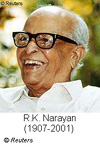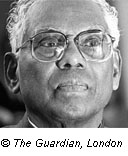
|
Blanca Hernández: My Encounter with R
K Narayan |
Editorial introduction | The article itself | References | The works of R K Narayan | Copyright of images | Background information
![]() The first anniversary of R K Narayan's
death (13 May 2001) has passed. R K Narayan was born in Madras in 1906.
He is one of the best-known Indian novelists writing in English. Among
his many novels, set in a southern Indian town, are: Swami and Friends
(1935), The Bachelor, The English Teacher, The Vendor of Sweets, A
Tiger for Malgudi. He spent most of his life in Mysore. He died on 13
May 2001. Graham Green was a life-long friend of Narayan and put him on
a par with Tolstoy, Henry James, Turgenyev, Chekhov and Conrad.
The first anniversary of R K Narayan's
death (13 May 2001) has passed. R K Narayan was born in Madras in 1906.
He is one of the best-known Indian novelists writing in English. Among
his many novels, set in a southern Indian town, are: Swami and Friends
(1935), The Bachelor, The English Teacher, The Vendor of Sweets, A
Tiger for Malgudi. He spent most of his life in Mysore. He died on 13
May 2001. Graham Green was a life-long friend of Narayan and put him on
a par with Tolstoy, Henry James, Turgenyev, Chekhov and Conrad.
Blanca Hernández, Professor of English in San Sebastián, Spain, lived in India for ten years and wrote a thesis about the women in R K Narayan's novels. She visited him at his home and corresponded with him for eight years. In this article she describes her experiences when trying to meet, and eventually meeting, the great man.
Blanca
Hernández:
My Encounter with R K Narayan
 © Tribune, India © Tribune, India
|
|
|
![]() Narayan got
into my life by an academic door that was almost a back door, and I was
about to close it and leave him out. India was my objective, but I had
chosen a different writer as the subject for my master thesis, and due
to faculty ins and outs, contrary to my wishes, I had to do my research
on Narayan.
Narayan got
into my life by an academic door that was almost a back door, and I was
about to close it and leave him out. India was my objective, but I had
chosen a different writer as the subject for my master thesis, and due
to faculty ins and outs, contrary to my wishes, I had to do my research
on Narayan.
I began to read his works just as I found them, and discovered that those writings contained the true India: crowded, mystic, beautiful and poor; with its long history, complicated and even cruel; its deep philosophy, its art... Although India had remained far away, as I read Narayan's writings I was feeling it nearer and nearer, so I decided to return there. That was in April 1984.
All the details regarding that journey made it a crazy adventure, but ten years in India give me a right to regard it as my second home, so I was off; Narayan was on my schedule. In London and Barcelona I had already been told that Narayan had a difficult character as well as an aversion to interviews. Although I am not easy to convince, the “Sahitya Akademi” (The Hindi Academy of Letters) in New Delhi gave me the coup de grâce. I was warmly welcomed, but everybody there agreed to what I already knew about Narayan. All day they tried to get him on the phone... in vain! in the end, they persuaded me to give up and not waste the short time I had going to the south, as the situation was quite uncertain. So I set my course northeast, to the tribal area in the mountains, the second point in my schedule.
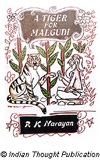 |
![]() On the plane back home, I began to
regret my decision. At least I did not return empty-handed: the
President of the Academy had given me Narayan's full address, telephone
number included, and at the airport I had found a periodical with a
long and interesting article about Narayan's last book that had not yet
been published, A Tiger for Malgudi.
I grasped at that to convince myself that it had been worth
riding the winds of three continents.
On the plane back home, I began to
regret my decision. At least I did not return empty-handed: the
President of the Academy had given me Narayan's full address, telephone
number included, and at the airport I had found a periodical with a
long and interesting article about Narayan's last book that had not yet
been published, A Tiger for Malgudi.
I grasped at that to convince myself that it had been worth
riding the winds of three continents.
In the early eighties, plane tracks turned and twisted a lot with intermediate stops, and during one of those stops my periodical disappeared. In my desperate search for the invaluable magazine, I turned the 747 jumbo upside down. I prayed to Lord Ganesh. The sympathetic crew radioed the last airport just in case a cleaner had removed my magazine and it could be found. But no such luck.
It was as if Narayan had the magical power to influence events against those who wanted to inquire into the writer's intimate adventure between his feelings and the words. He had written: “Having a living author on hand may be like having a live lobster on your plate.” (NARAYAN, R.K., 1969, page 66)
The problems are of a different nature, but several complications may arise and last. During one year Narayan had been the objective of my research, I had read all he had written, and all others had written about him; I myself had written about his intelligence, his sense of humor, sometimes sharp, his vehemence, his unconventional behaviour; I was especially impressed with the way in which women were treated in his works. All this made him a very interesting writer and meeting him an attractive challenge that had to be taken up, so I returned some years later - in 1991.
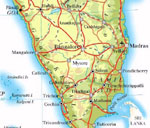 |
![]() Anu, a pretty and intelligent
young woman, with a strong personality, helped me with my first steps
towards Narayan. I met her on the coach from Bangalore to Mysore, on 10
September, the evening of my arrival in New Delhi from Spain. We
were the only two women who travelled alone in the normal crowd on an
Indian coach, and the only ones who did not get off at the obligatory
midway stop to have tea.
Anu, a pretty and intelligent
young woman, with a strong personality, helped me with my first steps
towards Narayan. I met her on the coach from Bangalore to Mysore, on 10
September, the evening of my arrival in New Delhi from Spain. We
were the only two women who travelled alone in the normal crowd on an
Indian coach, and the only ones who did not get off at the obligatory
midway stop to have tea.
Narayan was present in all my movements by land or by air, and I tried to verify whether my master thesis about the Indian woman, as I had understood it in Narayan's works, and even in my experience during the years I had lived in India, was valid. Therefore I was very interested in the situation of the women I met, the way in which they projected themselves and their behaviour. I asked Anu if she was from Mysore and whether she knew the way to Narayan's house. She said “Yes” to both questions and added that she would take me there that evening, although by the time we arrived, it would be night already. We found the house, so I had taken a step towards my objective; we arranged to meet in the morning.
Mr Chandru, Narayan's son-in-law, welcomed us warmly. The house was green and beige and by day, in the October sun, it gleamed gaily. It was the sort of detached house where an upper middle class family in India is expected to live. Next to it there was a small garden, well looked after. I noticed a twisted trunk, rather spectacular and unusual, and asked the elderly guard how it had got there. He did not know, but he knew that Narayan used it for concentration practice.
Some weeks later, I asked Narayan himself and he said that he had seen it in a village, and as he had liked it, the villagers had given it to him. It seemed that concentration practice had nothing to do with it. I doubted that I would pay a second visit to that house, so I asked permission to take some photographs of the inside - better something than nothing. In fact I returned three times and spent several hours inside that house I had labelled as unattainable, but that belongs to my second jouney to Mysore. The interior was tidy and simple, with a complete lack of ostentation.
| |
![]() Mr Chandru, the husband of Hema,
Narayan's daughter, no longer young, was charming and discreet. Narayan
was away for several days, so Mr Chandru advised me to deal with all I
had to do elsewhere in India (I had to go to Meghalaya in the far North
East) and phone Mysore from there. From what I had been told about
Narayan, I thought it was a kind way to get rid of me.
Mr Chandru, the husband of Hema,
Narayan's daughter, no longer young, was charming and discreet. Narayan
was away for several days, so Mr Chandru advised me to deal with all I
had to do elsewhere in India (I had to go to Meghalaya in the far North
East) and phone Mysore from there. From what I had been told about
Narayan, I thought it was a kind way to get rid of me.
I made the most of the day I spent in Mysore to get to know Malgudi, Narayan's fictional town. There I found the river Sarayu, where The Bachelor of Arts had seen Susila for the first time; the Mempi Hills, with the “Sadhu” and the tiger sharing their contemplative life, in A Tiger for Malgudi; the railway station, where Krishna, The English Teacher, was anxiously waiting for his wife who was certain to arrive with a lot of luggage and their baby as well. All these places can be found in most of Narayan's stories, along with the College, The Lane, Lawly Road and Kabir Street. Among the palaces and temples which make a jewel of this town, I remembered the Dashara Festival with the elephants almost robed in gold and silver, and the sacred dancers, so well described in The Man-eater of Malgudi, where the dancer with her own body and her dance, reaching the point of exhaustion, protected the elephant from being killed.
Another important aspect is nature's generosity to Mysore giving it giant trees and enormous rhododendrons covered with red flowers. I also tasted the extraordinary coffee from Mysore, always present in Narayan's stories and, of course, I took to it.
Even Anu was the living image of Susila in The Bachelor of Arts: as young as her, she was married to a bank manager, but she was still studying at Bangalore university for her M.A., so her little son of two was living with her parents, and she spent her weekends with him. No doubt, her life was already longer than that of Susila.
![]() The days were falling off the
calendar, that implacable enemy, and my stay in Meghalaya was coming to
an end. With some diffidence I phoned Mysore, Mr Chandru answered, he
was as charming as ever, and to my surprise he passed the receiver to R
K Narayan. My heart was beating fast and I found it rather
difficult to speak, but I did my best to be clear and to the point. I
expressed my desire to meet him. His answer was a display of his skill
to make others lose their bearings. For a while I was confused,
but I understood his tricks and told him that he would have to try
harder if he wanted to discourage me. He laughed and I felt
relieved. Suddenly he set the date for our meeting, provided I
phoned from Mysore on the preceding day.
The days were falling off the
calendar, that implacable enemy, and my stay in Meghalaya was coming to
an end. With some diffidence I phoned Mysore, Mr Chandru answered, he
was as charming as ever, and to my surprise he passed the receiver to R
K Narayan. My heart was beating fast and I found it rather
difficult to speak, but I did my best to be clear and to the point. I
expressed my desire to meet him. His answer was a display of his skill
to make others lose their bearings. For a while I was confused,
but I understood his tricks and told him that he would have to try
harder if he wanted to discourage me. He laughed and I felt
relieved. Suddenly he set the date for our meeting, provided I
phoned from Mysore on the preceding day.
My trek back home via Mysore started with stops in Guwahati, Delhi, Madras, and Bangalore. On 2 October I was again inside one of those ancient rickety coaches to Mysore. The moment I arrived at the hotel, I phoned as promised to agree the time for the following day..., or so I thought!
“We shall meet this evening, at 6.00, but phone again before coming. You will have only one hour.”
I was at a loss of what to do, it was 3.00 p.m. and I still had an unresolved problem: since passing through London airport, I had been trying to buy a good, small and discreet tape-recorder, but strangly, I had not found any. I rushed to town and found only a radio-cassette that was not good, neither small nor discreet, but recording Narayan's voice was top priority. I had not slept for over forty hours, I felt I had been playing hide and seek with the clouds, the trees and the stars; I was not really walking, was floating over an unreal space, I was so tired that I could not distiguish between reality and imagination. It seemed that mythical moment I had dreamt about for years, had arrived, at last I was going to meet my favourite writer personally!
![]() Rasipuram
Krishnaswami Iyear Narayan, was born in Madras, on October 10th,
1906 or 1907, the authors do not agree, and he did not like speaking
about his age, so it was better not to go into unnecessary problems. He
was full of a vitality that belied his age and that seemed to have
defeated the progression of time. He was unpredictable, and talking to
him, especially at first, one had the impression that it was very easy
“to slip up”. He was bursting with life and showed a great interest in
any subject or thing he believed was worthy of it. When he
smiled, he changed and looked much younger.
Rasipuram
Krishnaswami Iyear Narayan, was born in Madras, on October 10th,
1906 or 1907, the authors do not agree, and he did not like speaking
about his age, so it was better not to go into unnecessary problems. He
was full of a vitality that belied his age and that seemed to have
defeated the progression of time. He was unpredictable, and talking to
him, especially at first, one had the impression that it was very easy
“to slip up”. He was bursting with life and showed a great interest in
any subject or thing he believed was worthy of it. When he
smiled, he changed and looked much younger.
When I arrived, Narayan, his daughter Hema and Mr Chandru were waiting for me outside the house. We entered their sitting-room and, despite my nervousness, a very pleasant conversation began. Everything aroused Narayan's curiosity: the ethnics of Meghalaya, Spain, Franco, bullfights...
Quite embarrassed, I had got my radio-cassette out of my bag and had asked permission to record what I had thought would be an interview. I do not know what amused him the most, the size of my recorder or my embarrassement, but he was very amused. Narayan had given me only one hour, but three hours had passed when I decided to take my leave in order not to abuse my kind hosts. Then, in keeping with Indian hospitality, I was offerred something to drink, Mysore coffee of course.
Another big surprise awaited me: Narayan himself, with his reputation for not being very sociable, offerred me the opportunity to interview him the following day. I could not believe my luck! Again he limited the time, three quarters of an hour, but his generosity was greater than his toughness.
![]() In an atmosphere much more
isolated than that of the night before, Narayan and I alone were
together in a small sitting-room. My interview began. I had not
much experience in interviewing, so this was an ambitious start:
interviewing the great Narayan! I was really scared to make a mistake.
He was extremely kind and, at times, disturbing. I chose the title for
my master thesis: Woman in the Works
of R. K. Narayan because I had never found anything on the
subject in writings about his books, so I still feel a bit proud of it.
A feminine character is always present in Narayan's novels and usually
has an important role, although sometimes it is hidden and must be
searched for. Some of my questions were in that direction, and his
answers were full of respect, admiration and even love for women:
In an atmosphere much more
isolated than that of the night before, Narayan and I alone were
together in a small sitting-room. My interview began. I had not
much experience in interviewing, so this was an ambitious start:
interviewing the great Narayan! I was really scared to make a mistake.
He was extremely kind and, at times, disturbing. I chose the title for
my master thesis: Woman in the Works
of R. K. Narayan because I had never found anything on the
subject in writings about his books, so I still feel a bit proud of it.
A feminine character is always present in Narayan's novels and usually
has an important role, although sometimes it is hidden and must be
searched for. Some of my questions were in that direction, and his
answers were full of respect, admiration and even love for women:
- What do you think about women who decide to remain free and unmarried? (A point about which everybody asks me in India and which causes great surprise.)
“It's their own decision, you know; each one knows what is best. I don't have an opinion on that because I can't decide for others. To decide for others you must foresee what is coming ahead for future lives, I can foresee for myself, but for others I can't forsee it at all... I never dictate to others what they must do.”
- What do you expect of a woman? Is there a quality you should like to find in women?
“I don't know, they are all right as they are, they're better that men mostly, they're more attentive, helpful, spontaneous; in many ways women are better than men, so I don't have to expect any especial quality, they're all right. There are some stubborn, difficult women, they are few, there are not many of that kind.”
- What do you think of the western influence on Indian women?
“It's a good influence coming now. They're becoming more free, more sophisticated. I think it's quite good as long as they don't lose the Indianness of their own nature, I think it is a good influence in many ways: they groom themselves better, they move better, they are bolder. When they take charge of things they are very practical. I mean those who have been trained in foreign countries and come back, it's quite good, they're very different. Although there are also those who like getting divorced, that bad influence is also there.”
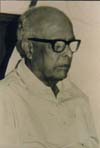 |
![]() This was the keynote of our
conversation; that was his mind, quite broad in the year 1991, when he
was 85.
This was the keynote of our
conversation; that was his mind, quite broad in the year 1991, when he
was 85.
We also talked about studies, religion, books, Graham Greene, his literary preferences... He liked poetry, but only up to that by T. S. Eliot, because he could not understand modern poetry. He was so humble that he did not say anything about good or bad poetry, just what he could understand. He liked history and good fiction and said that Graham Greene was his favourite writer.
![]() Speaking about him, Narayan not
only showed a literary preference, but a deep love for a friend to whom
he owed the publication of his first novel, Swami and Friends. As
it is usual for new writers, that book had reached Greene through a
common friend, seeking a publisher. At that moment it only
deserved some room inside the “drawer of oblivion”.
Speaking about him, Narayan not
only showed a literary preference, but a deep love for a friend to whom
he owed the publication of his first novel, Swami and Friends. As
it is usual for new writers, that book had reached Greene through a
common friend, seeking a publisher. At that moment it only
deserved some room inside the “drawer of oblivion”.
 |
On a rainy day, Graham Greene opened the drawer, read it and got enthusiastic about it. The world gained an interesting writer, and Greene got a second home. Later, after having named Tolstoy, Henry James, Turgenev, Chekhov and Conrad, Graham Greene wrote:
“Narayan (whom I don't hesitate to name in such a context) more than any of them wakes in me a spring of gratitude, for he has offered me a second home. Without him I could never have known what it is like to be Indian... ... No one could find a second home in Kipling's India or Forster's India.” (GREENE, G., 1981, page 26)
 |
![]() In Indian literary circles, it is
well known how much Narayan loved Rajam,
the pretty young woman he married, love that lasted beyond death and
was reflected in his own life and also in his writings. He never got
married again, and reading his books, she is often there, maybe under
the name of Susila or dressed
in a green saree.
In Indian literary circles, it is
well known how much Narayan loved Rajam,
the pretty young woman he married, love that lasted beyond death and
was reflected in his own life and also in his writings. He never got
married again, and reading his books, she is often there, maybe under
the name of Susila or dressed
in a green saree.
In The English Teacher, the death of Susila, Krishna's wife, is told very vividly: Krishna, the main character, is broken with pain and only with the help of a medium can he find some relief, as through him Krishna can feel Susila is near. Narayan has said that this is the most autobiographical of his writings (I do not forget My Days) and it is very easy to identify Susila as Rajam.
![]() The last paragraph of the novel
is delicious, full of tender love, romanticism and hope. Once Krishna has lost Susila,
his only desire is to meet her again, his fusion with her, which at
last happens at dawn, at a new daybreak, at the dawn of a new life:
The last paragraph of the novel
is delicious, full of tender love, romanticism and hope. Once Krishna has lost Susila,
his only desire is to meet her again, his fusion with her, which at
last happens at dawn, at a new daybreak, at the dawn of a new life:
“... When I opened my eyes again she was sitting on my bed looking at me with an extraordinary smile in her eyes... ... I'm here, have always been here... ... The first purple of the dawn came through our window, and faintly touched the walls of our room. 'Dawn!' she whispered and rose to her feet... ... We stood at the window... ... A cool breeze lapped our faces. The boundaries of our personalities suddenly dissolved. It was a moment... ... for which one feels grateful to life and death.” (NARAYAN, R.K., 1978, page 184)
I had intended to ask about that passage in my interview, although I was aware of the problem: if it was not fiction, it belonged to Narayan's most private sphere, and his generosity and goodness towards me deserved all my delicacy, but... how could I let the opportunity slip by? I dared ask him the question, but I felt so insecure and was so scared that I made a terrible mess of “gurus” and mediums. In the end everything was clarified, and I managed to ask him whether the end of that novel was true, and if in his case, the medium had worked. With a sober and serene attitude that impressed me, he answered just that it had because, if the medium is good, it always works.
My second 'interview' with Narayan was over, it had lasted one hour and a half. He was expecting a visitor, who arrived while I was still there. He left me for a while and returned with his last two books, which he signed for me.
 |
| Hema, R K Narayan's
daughter © Blanca Hernández 1991 |
![]() I returned to Narayan's house for
a third time; when I left, Hema was not there, and when I got to my
hotel I found a message: “Call Narayan's residence”. It was Hema, she
was ready to come to the hotel to say goodbye, so I went back. The way
in which I had been welcomed surpassed all my expectations... if I had
expected anything. Hema was the perfect Hindu woman: always present,
although she did not make any noise; devoted to her father and her
husband. I had the feeling that in her I had found a friend, but she
left us all too early, as Narayan said, “She jumped the queue” for
the... 'furtherance of life'.
I returned to Narayan's house for
a third time; when I left, Hema was not there, and when I got to my
hotel I found a message: “Call Narayan's residence”. It was Hema, she
was ready to come to the hotel to say goodbye, so I went back. The way
in which I had been welcomed surpassed all my expectations... if I had
expected anything. Hema was the perfect Hindu woman: always present,
although she did not make any noise; devoted to her father and her
husband. I had the feeling that in her I had found a friend, but she
left us all too early, as Narayan said, “She jumped the queue” for
the... 'furtherance of life'.
Before I said goodbye to Narayan, I asked him if I could write to him; his answer was typical Narayan:
“Yes, yes, you can write to me, I won't reply.”
![]() His words were full of kindness
and his eyes sparkled impishly. I believed him and was sure that I
would not receive a reply, but I wrote to him anyway: such an adventure
well deserved a letter. Two months later I received an Indian
aerogramme, the sender was R.K. Narayan!!! It was written by hand, most
of the aerogramme was written by him, but Hema and Mr Chandru had also
written their own messages. I could not believe what I had in my hands.
Our correspondence was not frequent, but lasted for eight years with
clear signs of friendship, his usual closing phrase was: “Come back,
this time we'll meet in Madras”.
His words were full of kindness
and his eyes sparkled impishly. I believed him and was sure that I
would not receive a reply, but I wrote to him anyway: such an adventure
well deserved a letter. Two months later I received an Indian
aerogramme, the sender was R.K. Narayan!!! It was written by hand, most
of the aerogramme was written by him, but Hema and Mr Chandru had also
written their own messages. I could not believe what I had in my hands.
Our correspondence was not frequent, but lasted for eight years with
clear signs of friendship, his usual closing phrase was: “Come back,
this time we'll meet in Madras”.
| Click here for printable version | Click here for printable version | |
| Click here for typed version | Click here for typed version |
 |
![]() When his messages stopped
arriving, I knew that his writing and his life were coming to an end,
that soon the heavenly vault of literature would lose one of its
sparkling wits, and India its most eloquent ambassador. He left us on
13 May 2001, and we have all lost a lot: Narayan was a convinced great
defender of human dignity because he believed in the spiritual values
of the human being. But we still have his books which are a compendium
of man's most legitimate aspirations made into daily life: freedom,
love, fidelity, nature, spirituality... all of it inside a setting so
splendid and diverse as India in miniature: Malgudi!
When his messages stopped
arriving, I knew that his writing and his life were coming to an end,
that soon the heavenly vault of literature would lose one of its
sparkling wits, and India its most eloquent ambassador. He left us on
13 May 2001, and we have all lost a lot: Narayan was a convinced great
defender of human dignity because he believed in the spiritual values
of the human being. But we still have his books which are a compendium
of man's most legitimate aspirations made into daily life: freedom,
love, fidelity, nature, spirituality... all of it inside a setting so
splendid and diverse as India in miniature: Malgudi!
 |
|
![]() The
Works of R K Narayan
The
Works of R K Narayan
(in chronological order of the first edition)
1935: Swami and Friends, 1978, Oxford, Oxford University Press.
1937: The Bachelor of Arts, 1979, Mysore, Indian Thought Pub.
1938:The Dark Room, 1976, New Delhi, An Orient Paperback.
1941: My Days, 1974, Mysore, Indian Thought Publication.
1945: The English Teacher, 1978, London, Heinemann.
1949: Mr Sampath-The Printer of Malgudi, 1993, London, Minerva.
1952: The Financial Expert, 1981, Chicago, U. Chicago P./Hein.
1955: Waiting for the Mahatma, 1979, London, Heinemann.
1956: Next Sunday, 1956, Delhi, An Orient Paperback.
undated: Lawley Road, New Delhi, An Orient Paperback.
1958: The Guide, 1982, Mysore, Indian Thought Publication.
1962: The Man-Eater of Malgudi, 1979, Delhi, Hind Pocket Books.
1965: Gods, Demons and Others, 1979, Delhi, Hind Pocket Books.
1967: The Vendor of Sweets, 1983, Harmondsworth, King Penguin.
1969: My Dateless Diary, 1969, New Delhi, An Orient Paperback.
1970: A Horse and Two Goats, 1970, Delhi, Hind Pocket Books.
1976: The Painter of Signs, 1982, Harmondsworth, King Penguin.
1977: The Emerald Rout, 1978, Mysore, Indian Thought Publicat.
1983: A Tiger for Malgudi, 1984, Harmondsworth, King Penguin.
1985: Under the Banyan Tree (Sous le Banian), 1994, Paris, Belfond
1986: Talkative Man, 1987, New York, Viking.
1990: The World of Nagaraj, 1990, New York, Viking.
1993: The Grandmother's tale(Le Conte de Grand-Mère), 1994, Paris, Belfond.
NARAYAN, R. K.: “Green Saree”, London Magazine, February-March, 1975
NARAYAN, R. K.: "Among Multitudinous Voices", Times Literary Supplement, 6 July 1984
© 2001 Blanca Hernández
![]() Some
background information
Some
background information
(Supplied by the Editor of Rochdale Writers
website)
R K Narayan was born on 10 Oct 1906 and died on 13 May 2001. (Birth: Some say 1907. Presumably he had, like most older Indians, and the Queen of England, two birthdays, the astrological [or physiological] birthday and a passport birthday [official or documentary birthday].)
He married Rajam in 1934. Their daughter Hema was born in 1936. Rajam died of typhoid in 1939. Hema died in 1994.
"His friend Kittu Purna, who showed some of his short stories, and his first novel, Swami And Friends, to Graham Greene in Oxford in the early 1930s. The book had already made the rounds of London publishers, and Narayan had advised his friend to "weight the manuscript with a stone and drown it in the Thames." ...
"When Greene surfaced from the war in the mid-1940s, the literary friendship resumed. It became a tradition for Narayan to send all his major fiction to Greene for an opinion before publication. For years, Greene edited the writing, cleaned up the grammar, supplied titles, and energetically sang his prodigee's praises in the literary world." (Guardian, London, 14 May 2001)
For a while Narayan ran his own publishing company, Indian Thought Publications.
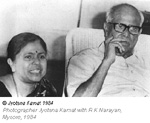 |
About the author
![]() Blanca Hernández was born in
Valencia and lives in San Sebastián, Spain. She studied Nursing and
Midwifery at Valencia University. She lived in India for ten years,
doing social work, setting up, organising and directing schools for
children and youngsters of the Khasi and Garo tribes (Meghalaya), in
North East India. She is now working on a doctoral thesis on "The
Semantics of Khasi" in the Dept. of Lingustics at Barcelona University.
(Khasi is an Indian tribal language.) When she returned to Spain, she
studied English linguistics and literature at Barcelona University,
where she obtained her MA, with a thesis on 'Woman in the Work of R. K.
Narayan'. She got her "Diplôme d'Etudes Françaises" at Lille University
(France). She has been Professor of General and Commercial English at
the Faculty of Business Administration, Deusto University, in San
Sebastian (Spain). She speaks Spanish, English French, Khasi and Garo.
Blanca Hernández was born in
Valencia and lives in San Sebastián, Spain. She studied Nursing and
Midwifery at Valencia University. She lived in India for ten years,
doing social work, setting up, organising and directing schools for
children and youngsters of the Khasi and Garo tribes (Meghalaya), in
North East India. She is now working on a doctoral thesis on "The
Semantics of Khasi" in the Dept. of Lingustics at Barcelona University.
(Khasi is an Indian tribal language.) When she returned to Spain, she
studied English linguistics and literature at Barcelona University,
where she obtained her MA, with a thesis on 'Woman in the Work of R. K.
Narayan'. She got her "Diplôme d'Etudes Françaises" at Lille University
(France). She has been Professor of General and Commercial English at
the Faculty of Business Administration, Deusto University, in San
Sebastian (Spain). She speaks Spanish, English French, Khasi and Garo.
Blanca Hernández
Bera-Bera, 69,
E-20009 - San Sebastián
Spain
